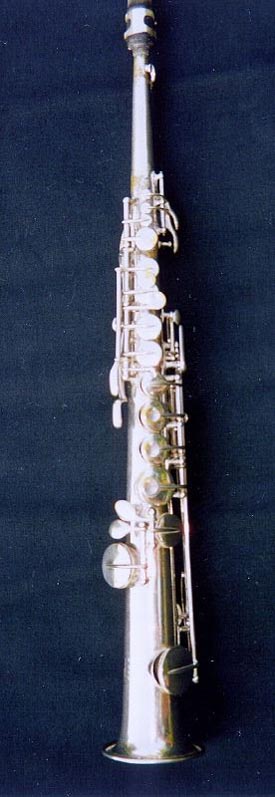| Early Buffet-Crampon
Models
Let's start with a bit of a timeline: Series I: 1866
to 1870; s/n 0 thru 792:
A. Sax's patent expired and a bunch of instrument makers, including
Buffet, jumped on the Sax bandwagon and tried to "improve"
upon the saxophone design. Buffet, however, instead of "reinventing
the wheel", is extremely faithful to Sax's
original design -- primarily because Buffet was a Sax licensee.
Well, in any event, there were no significant changes in their saxophone design, but it does appear that 1871 is the first year that the "Buffet-Crampon, Cie." logo was used :). While the first two series of Buffet horns are essentially Sax copies, the third series is shockingly different and introduces many interesting changes thoughout its long history. I will discuss this next series on a different page. A good thing to note: France had several different pitch standards in the 19th century. When Buffet's first sax was introduced, it was probably a A=435hz horn, which was the French standard of the time. By 1914, the new international standard pitch of A=440hz ("low pitch") was introduced. Buffets around this time are stamped "LP" or "HP" -- "HP" being "high pitch": an American standard where A=457hz. Why is this important? High pitch horns do not play in tune with modern horns and it is almost physically impossible to adjust down the 1/4-step-plus to A=440hz. Additionally, the modern Buffet company insists that all of their horns from 1866 on were also available as A=442hz horns. I tend to discount this statement because there's no evidence to support this and because adjusting down the 2hz is extrodinarily easy (in other words, there ain't much difference between A=440hz and A=442hz unless you're talking about electronic instruments). Adjusting up from A=435hz to A=440hz is a bit more difficult. So, if you find one of these older horns, look for the "LP" stamp near the "Evette & Schaeffer" engraving. If you don't see it, the horn might be fun to have as a collectible or if you do solo work (or work with electronic instruments), but not as a performance horn with modern ensembles. |
| Donate to the Vintage Saxophone Gallery Website | ||
|
|
||
Website copyright © 1997-2006 by Pete Hales.
Pictures/sounds/etc. used herein may have their own copyright and most are used by permission.
If you feel any image or soundbyte used here is in violation of copyright or for information regarding use/reproduction of this website's content, please e-mail saxpics@gmail.com
Comments, corrections, suggestions or picture submissions: saxpics@gmail.com



